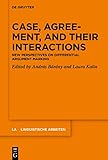Case, Agreement, and their Interactions : New Perspectives on Differential Argument Marking / ed. by András Bárány, Laura Kalin.
Material type: TextSeries: Linguistische Arbeiten ; 572Publisher: Berlin ; Boston : De Gruyter, [2020]Copyright date: ©2020Description: 1 online resource (IX, 353 p.)Content type:
TextSeries: Linguistische Arbeiten ; 572Publisher: Berlin ; Boston : De Gruyter, [2020]Copyright date: ©2020Description: 1 online resource (IX, 353 p.)Content type: - 9783110665765
- 9783110666236
- 9783110666137
- online - DeGruyter
- Issued also in print.
| Item type | Current library | Call number | URL | Status | Notes | Barcode | |
|---|---|---|---|---|---|---|---|
 eBook
eBook
|
Biblioteca "Angelicum" Pont. Univ. S.Tommaso d'Aquino Nuvola online | online - DeGruyter (Browse shelf(Opens below)) | Online access | Not for loan (Accesso limitato) | Accesso per gli utenti autorizzati / Access for authorized users | (dgr)9783110666137 |
Frontmatter -- Contents -- List of abbreviations -- Preface and acknowledgements -- Introduction -- Cumulative effects in differential argument encoding and long-distance extraction -- Types of structural objects -- DOM and DSM in Turkish -- Abstract and morphological case in a nominative–accusative system with differential case marking -- DOM and dative in (Italo-)Romance -- Topicality and differential object marking in Mandarin Chinese: Identity and variety in an array of structures -- Estonian speakers’ representation of morphological case -- Index
restricted access online access with authorization star
http://purl.org/coar/access_right/c_16ec
Differential argument marking has been a hot topic in linguistics for several decades, both because it is cross-linguistically widespread and because it raises essential questions at multiple levels of grammar, including the relationship between abstract processes and overt morphological marking, between case and agreement, and between syntax and information structure. This volume provides an introduction into the current state of the art of research on differential case marking and chapters by leading linguists addressing theoretical questions in a wide range of typologically and geographically diverse languages from the Indo-European, Sinitic, Turkic, and Uralic families. The chapters engage with current theoretical issues in the morphology, syntax, semantics, and processing of differential argument marking. A central issue addressed by all the authors is the adequacy of various theoretical approaches in modelling (different varieties of) differential case marking, such as those determined by topicality, those driven by cumulative factors, and those that involve double marking. The volume will be of interest to students and researchers working on cross-linguistic variation in differential marking and its theoretical modelling.
Issued also in print.
Mode of access: Internet via World Wide Web.
In English.
Description based on online resource; title from PDF title page (publisher's Web site, viewed 25. Jun 2024)


